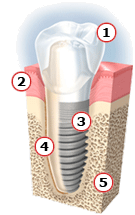Dental Implants
Introduction to Dental Implants
Dental Implants– are one option to replace one or several missing teeth. Dental implants are titanium devices/screws that replace the root of the tooth. Dental Implants are placed into the jaw to provide a sound foundation for an artificial tooth (crown) or denture to be placed on it. Once attached, your new tooth or teeth will restore your bite, prevent bone loss, maintain your speech, begin to smile again with confidence and enable you to chew properly once again. Please read below for more detailed information.

- Ceramic Crown
- Gum
- Dental Implant
- Tooth Root
- Jawbone
Dental Implants FAQ’s
What are dental implants?
Dental implants are artificial tooth roots that are surgically anchored to the jaw to hold a replacement tooth, bridge or denture in place. One of the major benefits of implants is that they do not rely on neighboring teeth for support and they are permanent and stable. Implants are a good solution to tooth loss because they look and feel like natural teeth.
What are dental implants made of?
Dental implant material is made from different types of metallic and bone-like ceramic materials that are compatible with body tissues. Most implants are made of titanium, which bonds well with bone and is biocompatible, making it an ideal material for implants.
How are dental implants placed?
First, a general dentist, oral surgeon, or other specialist will perform surgery to place the implant’s anchor in the jaw. The surgery can last from 30 minutes to several hours depending on the number of dental implants placed. It may take as long as six months for the jaw bone to grow around the anchor to hold it firmly in place. Once the implant is stable and the gums have healed, the dentist or specialist makes the artificial teeth and fits them to the post portion of the anchor. Your dentist will work with you to create an implant that fits well and is comfortable and attractive.
Who should get dental implants?
Implants are not an option for everyone. Because implants require surgery, patients must be in good health, have healthy gums, and have adequate bone structure to support the implants. While lack of adequate bone support is a limitation, additional procedures maybe available to create a good implant site. People who are unable to wear dentures also may be good candidates. The success rate for implants decreases dramatically among those who suffer from chronic problems, such as clenching or bruxism, or systemic diseases, such as diabetes. Additionally, people who smoke or drink alcohol may not be good candidates. For more information, talk to Dr. Murphy or Dr. Shivji at Queen’s Park Dental.
What is the difference between dental implants and dentures?
While dental implants are permanently fixed in the mouth, dentures are removable. A conventional removable full denture depends upon support from the bone and soft tissues rather than being solidly fixed in place; as a result, dentures may not offer as much stability as implants.
How do I care for dental implants?
Poor oral hygiene is a main reason why some implants fail. It is important to floss and brush around implants around implants at least twice a day. Your dentist will give you specific instructions on how to care for your new implants. Additional dental cleanings (up to four times per year) may
be necessary to ensure that you retain healthy gums.
be necessary to ensure that you retain healthy gums.
How will I adjust to my new dental implants?
Most people adjust to implants immediately; however, some people feel slight discomfort and notice differences in chewing or speech for a short time. Patients will soon see a difference in
their confidence level and enjoy their new smile.
their confidence level and enjoy their new smile.
Dental Implants – High-Tech Teeth
Consequences of Missing Teeth
Dental Implants FAQ
How to Choose an Implant Dentist
Are You a Candidate?
For more information check out our Blog on Dental Implants.
Source: Academy of General Dentistry which Dr. Darcy Murphy is a member of
For more information about dental implants, click here.

